What makes a sports car a great or even the greatest sports car? Is it all about handling, or is it power in combination with handling? And what about design, does it add greatness to a sports car? And top speed, positioning of the engine and the drive train?

Rules, are there any?
Of course, to a certain point cars in general, and especially sports cars, are all about percipience and emotion. Senses differ from human to human. No BMW 2 serie GTs, Mitsubishi Carisma’s, Pontiac Azteks, Fiat Multipla’s, Ssangyong Rodius’ and AMC Pacers would have been sold ever – or have been designed in the first place – if a certain rigid framework would exist for good car design; apparently some people sensed these cars as a good buy or as a car they could stand out from the crowd with.
Sure, some basic rules apply for a true sports car. In its strictest sense, it should be a car with two seats, a compact chassis and sleek styling. It has to be quick and agile with a low centre of gravity and it should handle and corner better than decently. Storage space and luxury are not at the top of the list when boxes have to be ticked. Driving fun is.
For me though, the greatest sports car should have more to offer. For instance, it should be from a car brand with heritage, with history. It should also have a special status, a significance within the brand. And it shouldn’t be right around every corner.

My view
Depending on the occurrence to mark the ‘date of birth’ of a car – press presentation of a mock-up (12 September 1995, Frankfurt Motor Show), or start of sales (1 August 1996, registration P919 YPH) – the Lotus Elise celebrates her 25th anniversary in this period of time. For me, this little sports car ticks all the boxes to become one of, if not the greatest sports car. It’s not as fancy as Ferrari’s, not as German as Porsches, not as fast as Aston Martins or McLarens and not as suave and sophisticated as Maserati’s. It has a lot of other things going for it though. Next to its awesome drive and handling, its beautiful lines from which especially its back side stands out from almost anything else, the innovative chassis and the sheer driving fun, it has heritage written all over it.
How many sports cars can be honoured to have saved a brand from bankruptcy? How many sports cars go by the name of ‘the re-invention of the sports car’? How many have been titled ‘Icon of Icons‘ (2019 poll of UK motorists), wear the name of a person with pride and look as good in modern day life as they did 25 years ago? For how many sports car does all this apply? It does for the Elise. The Greatest Sports Car in my bubble.
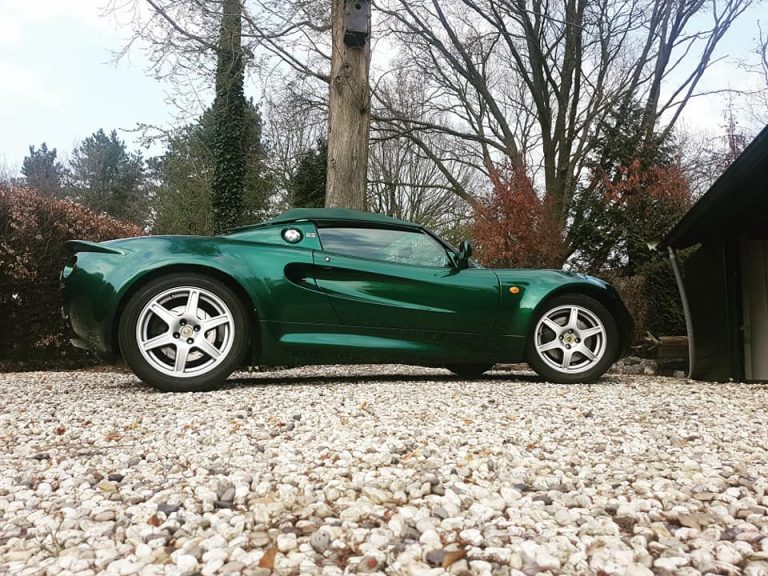
A little bit of history
Early ninetees, the new Elan M100 with its basic design, Isuzu engine and front wheel drive train – the first and (hopefully) last Lotus to go front wheel drive – was a terrible mistake in the eyes of many Lotus fans and buyers of sports cars. Mazda’s MX5/Miata won the sports car battle that was going on with ease. Lotus Cars seemed ready to be declared bankrupt, as had happened to so many British car makers before.
It seemed there was only one way out of this mess: Lotus Cars had to go back to its roots of light weight and innovation. Someone had to take the chance to be brave enough to change what Lotus Cars had become. That someone was Romano Artioli, a charismatic and succesful Italian entrepeneur who also owned Bugatti Automobili at the time and who was responsible for reviving that marque and for building the unsurpassed Bugatti EB110.
In 1993 he acquired Group Lotus. He saw added value in Lotus Engineering for Bugatti and decided that Lotus should look back to its core values of innovative design and superb handling. To performance cars that achieve their speed through light weight rather than huge engine power.
Tony Shute was given the project code named M1-11 with a big brief – ‘realise a car that revives Lotus with the true ideals of the company’s founder Colin Chapman’. So, the list of objectives was quite long and challenging. Amongst other goals, M1-11 should become a sports car with the spirit of the Lotus 7 and the vision of the Lotus 23. In other words, high performance through low mass. It should be highly distinctive, able to become a cult object. And deliver a responsive, fun and involving ride.

Julian Thomson
Romano Artioli appointed young car designer Julian Thomson, who was employed at Lotus for a few years at the time, head of design of the project. I’ve met Julian last summer at Caffeine & Machine during the Cotswolds Classic road trip I had organised (Bends & Curves road trips is a hobby that got out of hand a bit). We spoke about this period of his life; editor Jan-Bart Broertjes of Dutch Lotus Club magazine Lotus Letters, who participated in the Cotswolds tour, reported about it:
After Julian spent his school days drawing cars, resulting in poor grades, he ended up at the Royal College of Art in London, where he eventually graduated from a name known in Lotus circles: Peter Stevens. During a postgraduate internship at Ford UK, he then met Ian Callum, the man he succeeded as Jaguar’s top design boss. But Julian’s first real job was at Lotus, where Peter Stevens was in charge of the design department at the time. He took on his protégé and Julian remembers his first assignment: “I drew the wheels for the Stevens Esprit!”
Julian remembers very well when Romano Artioli came on board. “It was a culture shock. For instance, his way of greeting was to squeeze your cheek hard with one hand and then give you a punch in the stomach with his other fist. His intention was you had to slap him back; if you fended off, you weren’t much of a man in his eyes. I slapped back and he remembered that. A few days later he phoned me, apparently he had some kind of staff list at hand. “Who-and-what’s that guy?” He’s OK, I said unsuspectingly. “And that one, is he any good?” Mwah, I said, “OK, then he’s out!” The following Monday I had risen three levels, I was Head of Design! You bet Artioli wasn’t popular with everyone. At one point a coup d’état was planned behind his back. He got wind of it and came up with a plan: all noses the same way. He called the newspaper, borrowed a few F1 cars from Clive Chapman and had all the staff show up for a press conference and a group photo on the square in front of the building. When the beramers from the coup wanted to go back into their offices after the photo session, their desks were cleared and their passes were no longer working!”.
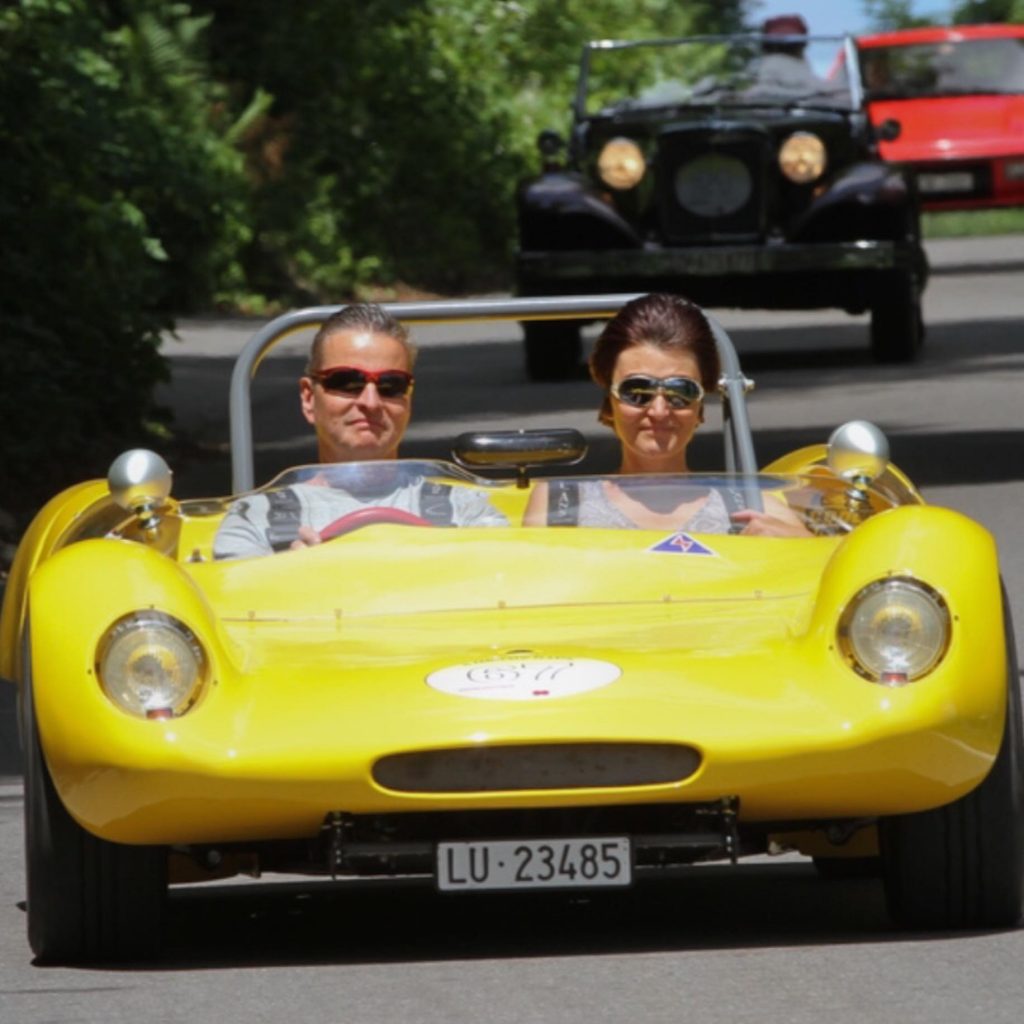
Julian and his team, together with chassis engineer Richard Rackham would end up creating the saviour of Lotus. Project M1-11 was a go with, as said, the Lotus Seven and Lotus 23 as role model and – suprisingly – a Ducati motor cycle and the Ferrari Dino (and other Italian sports cars of the sixties) as inspiration. Hidden under the body clams but inside the car in full sight, the Lotus Elise’s chassis is a big part of its success. It’s a work of genius. Chassis engineer and designer Richard Rackham’s insight was to construct the entire chassis out of a collection of aluminium extrusions that are bonded (glued) together. This was never done before in the car industry. Extrusions are strong and easily manufactured with complex cross-sections. Bonding allows for thinner aluminium than welding as it has a larger material area to transfer loads between members and avoids material degradation due to the heat of welding.
An outstanding appearance and brilliant bone structure isn’t enough to get things going. The Elise needed a heart too. The Rover K-series engine (118 bhp) was chosen by the project team to serve this purpose. Other engines that were taken into consideration were several GM Ecotec engines (all benefitted from Lotus engineering) and the Ford Zetec engine. Especially the Ford Zetec was quite bulky. With quite good reputation and a weight of about 100 kg – which meant it weighed at least 30 kg less than the others – the K-series engine was picked.
The name giving
Romano Artioli named the new Lotus sports car after his first born granddaughter Elisa, who was just two and a half years old when the Lotus Elise was launched at the IAA or Frankfurt Motor Show on 12 September 1995. After the chassis had been revealed, from under a ‘I am Elise’ cloth on a rotating platform, Elisa appeared in the brand new Lotus Elise concept car wearing yellow trousers and a ‘I am Elise’ t-shirt.
Launching the car in Frankfurt and naming the Lotus after his granddaughter were two of many strategic masterpieces of mr. Artioli. First of all, it was planned to present the Elise at the London Motor Fair in October 1995. But Romano Artioli decided differently, thus putting extra pressure on finishing the prototype in time. Due to this, the Elise was presented in Frankfurt on glass fibre wheels! But his decision paid off; the Elise and its innovative chassis were the undoubted stars of this major occasion in Germany, drawing much more press and public attention than rival Renault Spider which was also build on an aluminium – but welded instead of glued – chassis. A presentation in London wouldn’t have had the same effect.

Deciding on the name of the M1-11 was a tough break to say the least. Although many technical barriers were broken in the design and building process, one of the earliest and most time consuming tasks faced from the January 1994 engineering meetings onward, was determination of the name. M1-11 had grown to such a familiar name that most people involved thought that One Eleven would be the name for the new born. Not Romano Artioli. Also other ideas such as 711, LSC (Lightweight Sports Car), Apex, Aurora and Europa didn’t make it. In August 1995, a month before the public debut, Romano Artioli commented: “The car’s drive and handling, acceleration and braking power excel all comparisons – not to mention its safety, its beauty. In short it’s a winning model for Lotus, and it’s for this reason that I choose to name it after the great love of my life who came into the world at the same time … Elise.”
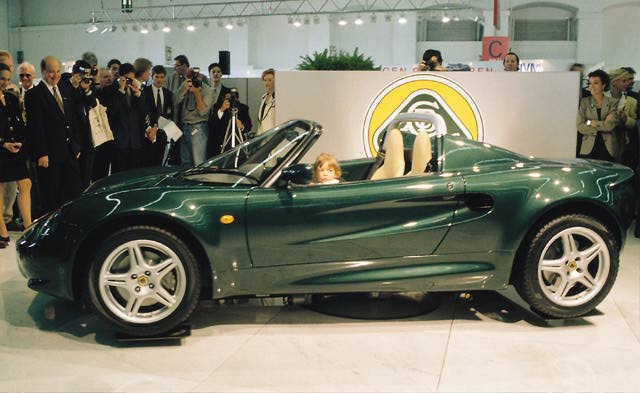
Naming cars after people had been done before and was done afterwards. Ferrari Enzo and Sergio, “Ferrari” Dino (the name honors Ferrari founder Enzo Ferrari’s late son, Alfredo “Dino” Ferrari – also an inspiration for the Lotus Elise as written above) and Pagani Huayra BC (BC stands for Benny Caiola, a best friend and first customer of Horacio Pagani) to name a few. Not so many cars were named after a female though; the list is not much longer than Alfa Romeo Giulietta, TVR Tina (really!) and Lotus Elise.
Today, Elisa is the leading person in keeping the Elise-heritage alive. She and her silver Elise travel Europe and the world to spread the word. Together with Joerg Uhr she has established Delightful Driving, an esteemed cooperation partner of Bends & Curves for organising road trips.

Variations and offspring
The Elise became a huge success, to say the least. Much more cars were sold than what was anticipated for. About 12.000 118bhp Elises were sold and next to that about 2.000 variatons on that car such as the Elise Sport 135/160/190 (all referring to bhp), Elise 111S and the Exige, the “Elise coupé”. The one-off Elise Sprint was a concept car that was restyled by Julian Thomson and his team to an Elise without a windscreen. This was replaced by a blade. Watching the slow sales of rival Renault Spider Lotus never needed to progress the idea any further than a show car. However, it was auctioned off to a Lotus dealer in Salisbury who turned it into a road legal car, registered as LOT 115.
Some offspring were more than just ‘a variation’. Well-known examples are the Elise GT1, 2-11, Vauxhall Speedster, Tesla roadster. The Lotus 340R (January 2000, 340 build) certainly deserves a spotlight. This striking model was based on the Elise and created in collaboration with Autocar Magazine. It was the stark Elise that the hardcore among Lotus design staff always wanted to build. Although the car had no doors and hood (as early design drawings of Julian Thomson for the Elise had showed too), the design brief of 500 kg was never met. The 340 bhp per tonne was also missed. Nevertheless, it was a brave step of Lotus to get the car in production, with 177 bhp in 675 kg.

Tony Shute, the Elise project manager, although proud on what the team has accomplished has always been disappointed that the weight of the Elise turned out more than was set as a goal. He noticed that the transparant bodies on the 1:10 scale model car his son Robin raced (they say it was a scale model of the Elise GT1) proved to be extremely light and very durable. He had saved the prototype 340R chassis from total destruction and decided to build the Elise Expose, with 545 kg a super light variation on the 340R. With an uprated VHPD K-series engine (182 bhp) and polycarbonate body it came close to the power to weight ratio the team had been aiming for. Tony was succesful with the car in hill climbs, only to be beaten by the likes of Audi Quattro with 600 bhp and 1.000 kg of car. For Tony it proved that Colin Chapman was right. With the Expose he became aware how low weight sharpens the response of a vehicle, not just in acceleration but also in braking and cornering. It’s a unique car which is still owned by Lotus, as far as my information goes.
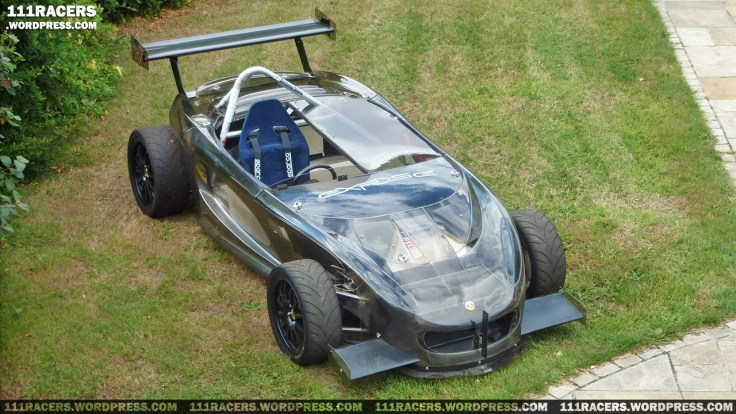
Another one-off offspring of the Elise is the Electrified Elise. Many think the Tesla roadster was the first electric Elise but it wasn’t. In 1997 an electric powertrain was put into a S1. This Zytek Lotus Elise is an electric sports car that was jointly produced by Lotus and Zytek from 1998 until it was discontinued in 2003. The Elise was the perfect sports cart to electrify, due to its low weight. With the electric powertrain and batteries it reached a kerb weight of 875 kg (1,929 lb). 250 nickel-cadmium batteries provided 300 volts (at full charge) to two Zytek oil-cooled brushless DC motors, which delivered a total power of 201 bhp and torque of 100 Nm. These motors were each mated to a single-speed, fixed ratio transmission. Its acceleration time from 30 to 70 mph was 5 seconds and from 0 to 90 mph 11.2 seconds. The car was governor-limited to 90 mph (145 km/h) to conserve charge. The range per charge was typically 100 to 120 mi and the car can be re-charged within an hour.
The greatest sports car
During our meeting at Caffeine & Machine, Julian Thomson looked back to 25 years ago. He is still waffled about the amount of owners who use the Elise as a daily driver. With a smile on his face he said: “The funny thing is, for years Lotus was the worry child of the British car industry, while Aston, Morgan, Bentley and so on all did fine. Now it’s the other way around, Lotus is on the road up and all the other brands are having problems in one way or the other”.
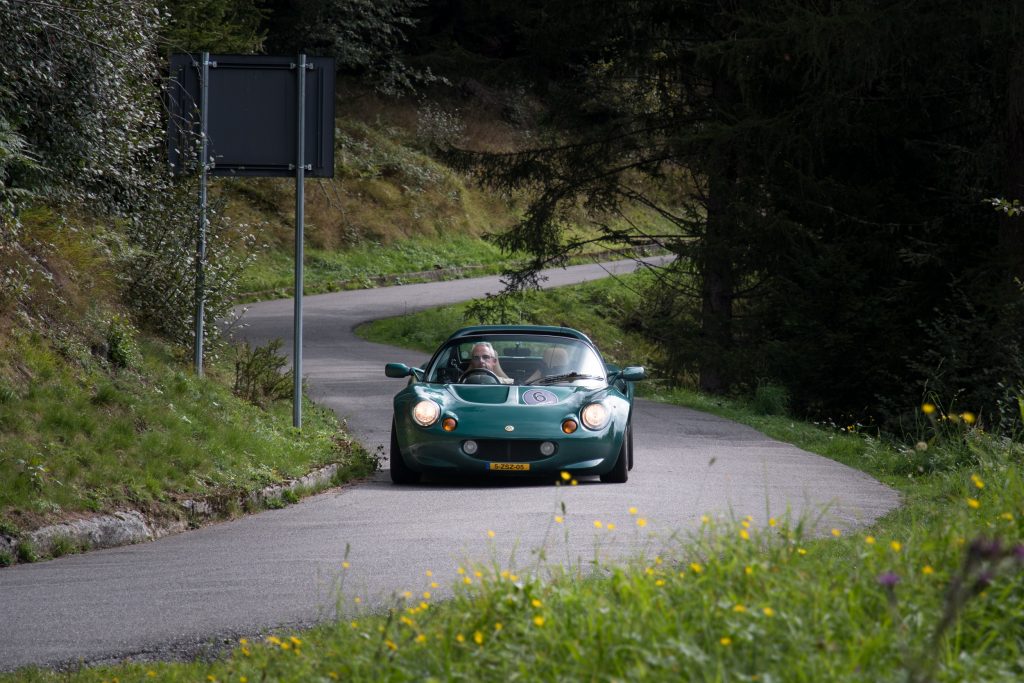
Without the Lotus Elise, this wouldn’t have been possible. Lotus would have probably ceased to exist or at least it wouldn’t be where it is now. The Elise is a proper Lotus. Lightweight, great design, stiff, quick, nimble, awesome handling, innovative and it uses someone else’s engine and gearbox. With designing, engineering and building the Elise, the team at Lotus Cars succeeded in developing a car with which the owner builds up a relationship, like a marriage. After you have get to know each other you want to stay together even when times get rough. You forgive the flaws, even when it’s raining and you’re in the pitch black dark in the Italian Alps and it just won’t start (yes, talking from own experience). You will still love her.

Does the Elise deserve to be called The Greatest Sports car? That will always be a personal opinion. For me, she is. The re-invention of the sports car. Colin Chapman would have been proud.
Sources
- Lotus Elise – The Official Story (Jeremy Walton)
- Graham Borrajo (car history video producer)
- Julian Thomson
- Jan-Bart Broertjes, Lotus Club Holland
- Sans Mechanical Museum – Steve Green and Peter Crook (Lotus Expose)
This article was written by Jan Blom (Bends&Curves Road Trips) and was printed in the January 2021 issue of Club Lotus News, the official club magazine of Club Lotus.

One response
The front wheel drive Elan is actually a beautiful car. Whilst not as quick and sprightly as the Elise handles very well on a track day!
I love mine but I also love all the Lotus cars from day one.